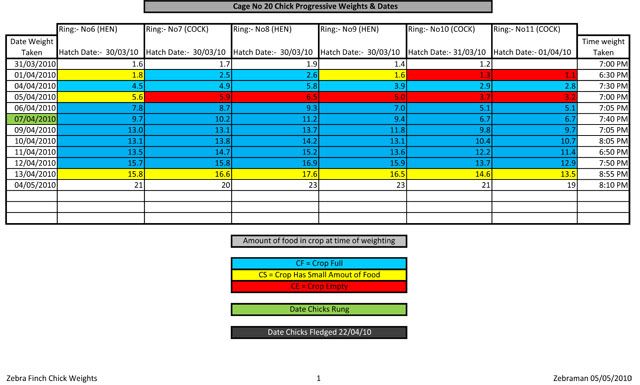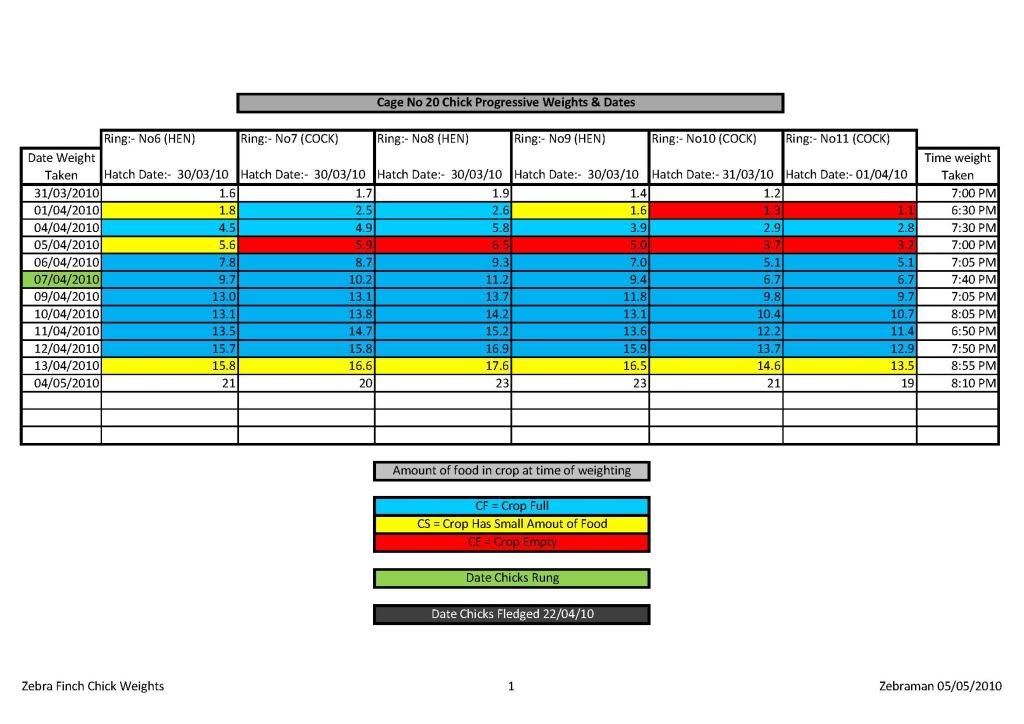-
Content Count
2,040 -
Joined
-
Last visited
Posts posted by Zebraman
-
-
So if I’ve got my calculation correct the full orange bodied birds sell from £47.00 to £113.00 that's a good price compared to what they sell for in the UK?
-
Welcome to the forum Alejandro.I see you are member of the Puerto Rico ZFC.I look forward to reading your posts.Regards,Gary
-
This is the first time I have completed a study on weight and I’ve learnt a lot from this first attempt. One of the areas that I did not cover was the weight of the parent birds prior to hatching and after the chicks had weaned. Do the parent birds lose weight during this trying process? If this is the case how long does it take them to restore their reserves?
Gary.
-
Well, I have to admit that I got this one wrong!!! Grey cheek it is then. Many thanks for all your replies. Gary.I'll leave the vote open for a while though, just in case

-
Welcome to the forum Darwish, I’m sure you will find a lot of interesting information on here. I hear that one of the favoured mutations kept in Dubai is the orange breasted Zebra Finch, is this still the case? Gary.
-
Normal Light Backs..........



-
OOOH, what a good question? Being a person who has a problem sticking with a one single colour as i think I have one of nearly everything, this is a very difficult question for me, but if I had to choose one then it would be the Normal as this was the colour I started with as a young boy and it’s always had a special place in my setup. There’s not many true Normals about these days as the majority are split with so many other types. I’ve been trying to remove the splits from mine for a number of years now. Good question Allan.
-
I weighed the young again last night and was pleasantly surprised to see how some of them had improved, all the young have now been removed from the parent birds and are currently going through a moult. I was amazed to see that some of the hens are heavier than the cock birds? My next step will be to weigh them again once they have full adult plumage. I hope you find the information informative.
Gary.

As before, I have also made the file available for download to members: -
-
I Paired up Ten more birds over the weekend:- 1. Lightback x Lightback 2. Fawn x Fawn 3. Normal x Normal 4. CFW x CFW 5. CFW x Grey Cheek Fingers crossed they should start producing soon as things are a little on the slow side at the moment. Gary.
-
Welcome to the forum Allan. As Scott has said not many member yet, but I’m sure the numbers will grow once the word gets around. I look forward to reading your post. Gary.
-
Hi Lyn, Firstly no needs to apologise, we all have to start somewhere. Your story about the dove is very interesting and is one that many an avian enthusiast can relate too. I’m not sure about the chaffinch, but the doves and the canary should be no problem in a mixed aviary with Zebra Finches. I would personally start with two to three mixed pairs, but just make sure you put plenty of nest boxes up as it will reduce the risk of squabbling. Also try to place them well apart as zebs become quite territorial when they are nesting. It’s very rare that Zebs will kill each other especially in an aviary, the only circumstances that this may arise is when they are keep the in breeding cages with two cock birds and one hen and a breeding box is placed to encourage them to breed, this is when the squabbling usually starts. If you’re not intending to breed this species, then I’d purchase some aviary bred cock birds as these are the most colourful and readily available. The reason why I say aviary bred as this type of bird will be used to being in a flight, where as a cage bred bird will need some time to get established in a your aviary. Hope this helps, Gary.
-
Welcome to the forum,I'm sure the members will give you all the support and advice you need. There's a good mix of breeders on here so just ask as much as you like.Gary.
-
Well, it looks like the two infertile eggs have done the job as the chick fledged yesterday and it’s on the perch already. Both legs seem to be in perfect condition so fingers crossed that it will continue to go form strength to strength and be another asset in my setup. Gary.
-
All these chicks are developing into good sized birds, it seems that my theory about the less chicks the bigger the size doesn’t hold water in this case? I’m going to weigh them again over the weekend to see how their weight has increased.
Gary.
-
Went in tonight and boy has this chick put some weight on, it looks like it will be a good sized bird. It won’t be long before it fledges and I’ll know if the egg trick worked? Gary.
-
Looks like the infertile eggs I placed in the nest box are starting to do the trick, I looked in the nest box this evening and the chick has started to pull its legs in, so I'll keep my finger crossed?Gary
 ;)
;) 
-
I went in to the setup tonight and did my ususal rounds after I had fed all the birds, on inspection of one of the nest boxes form a pair that had hatched a sole chick (First Round), I found that the cock bird has been sitting really tight on the chick, which had cause it to start developing splayed legs.As the chick is only Five days old, I decided to place a couple of eggs in the nest which had been laid by my spare hens. Hopefully this will stop the cock from pushing down on the chick and maybe help the legs to recover before it's to late?
-
This year I have decided to conduct a small study in to the growth weights of chicks from the first stages of the egg to the point where a bird is considered to be a fully grown fledgling.
Just to test the water a little, I recently selected a pair of CFW’s and started the process from the point where the chicks had hatched.
To allow me to achieve the result I required I purchased two sets of scales, one that would permit me to weigh the chicks from the early stages of hatching (0.1gram upwards) and another that would start from 1grm upwards to 50grms, this scale was big enough to place a show type cage on so that I could weigh the birds once they had fledged. Both scales also have the ability to be set to zero once an object was placed on them.
The sheet below shows the results I have collated so far, I was astonished to find how quickly each bird gained weight and developed. I also noted several points of interest, such as the time the bird was weighed and whether or not the crop was full or empty.
My next step will be to carry out this study from the first day that the eggs have been laid, but I will need to make sure that I select the correct pair as I do not want the birds to leave the eggs mid way through incubation. Is anyone aware of this type of study being conducted with Zebras or other birds?

I have also made the file available for download below:-
-
 1
1
-
-
Hi Sammy,I'm pleased to hear that Zeb has found a new home. Well done for all the hard the work you put in.Has he gone to someone local?Gary.
-
Hi Scott,Nice selection of birds. It will be interesting to read how things progress with your first round. Best regards, Gary.
-
Hi Lawrence, Did you get any further with the answer to your question? Gary.
-
There is a bit of a debate on the colour of this bird. The picture was taken in very low light level and the lens used was quite slow in comparison. I have been studying this bird for a number of weeks, but I would like to put your thoughts to a poll. I’ll reveal the results in a week’s time. Many thanks,Gary.
-
Hi Lawrence, Wooden nest boxes are very good I used them before I started using the plastic type. It is normal for birds to soil the nest box at night, they will normally lift themselves up and push their droppings on to the side of the nest. This should dry out during the day and may drop down in to the middle of the nest. Have you seen them taking dropping in to the nest? If they are try to give them some extra nesting material which should stop them taking droppings in to the nest. Once the hen has started laying this activity should stop. Hope this helps Gary
 ;)
;) 
-
Hi Shane, Welcome to the forum. If there’s anything you need help with please feel free to ask. The forum is in its infancy, but there are a wide variety of breeders already registered. Best of luck for the coming season. Gary
 ;)
;) 




New member from Dubai
in Introduce Yourself
Posted · Report reply
I think I'll start exporting!!!!